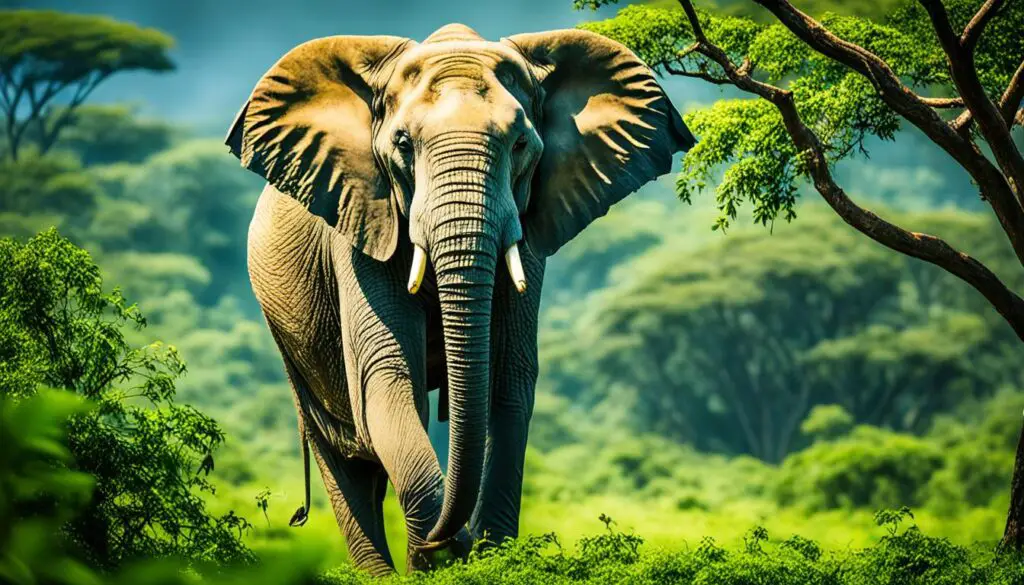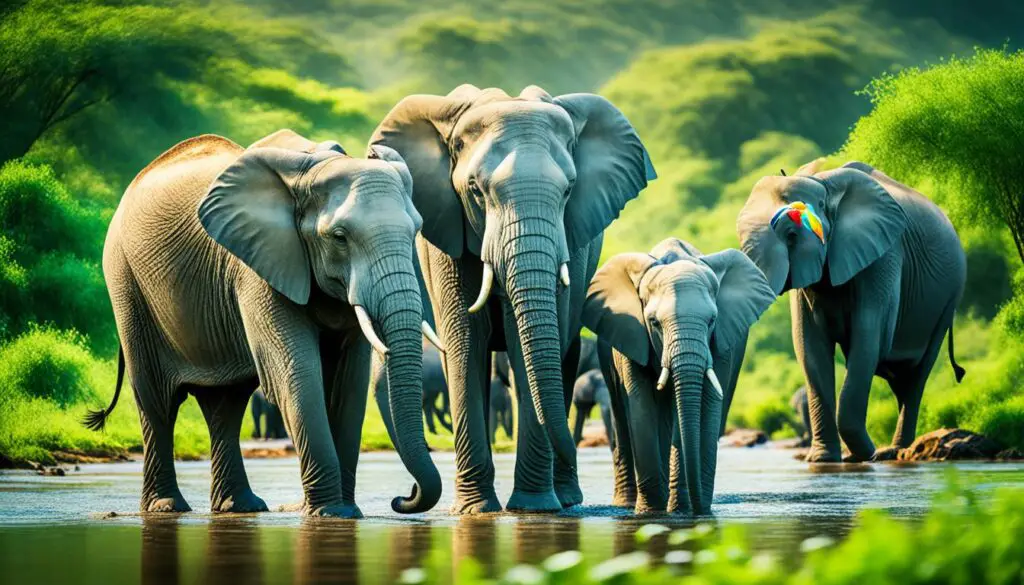Did you know that Myanmar, formerly known as Burma, is home to a staggering biodiversity of animal species? This Southeast Asian country boasts a rich and diverse ecosystem, encompassing tropical rainforests, wetlands, mountains, plains, and coastlines. However, the unique wildlife of Myanmar is now under severe threat due to human activities, leading to the endangerment and possible extinction of many species.

Key Takeaways:
- Myanmar is a country in Southeast Asia known for its incredible biodiversity.
- Various ecosystems, such as rainforests, wetlands, and mountains, support diverse animal species in Myanmar.
- Human activities pose a significant threat to the survival of Myanmar’s unique wildlife.
- The conservation and protection of endangered species are crucial to preserve Myanmar’s biodiversity.
- Efforts are being made by organizations and initiatives to safeguard the country’s wildlife and their habitats.
National Parks and Wildlife Sanctuaries
Myanmar is home to a number of national parks and wildlife sanctuaries that play a crucial role in the conservation and protection of the country’s unique wildlife. These protected areas provide a safe haven for rare animals and contribute to the preservation of Myanmar’s biodiversity.
Alaungdaw Kathapa National Park
One notable national park in Myanmar is the Alaungdaw Kathapa National Park, located in the northwest region of Sagaing. Spanning over 1,605 square kilometers, this park is known for its diverse range of mammal species. Visitors to Alaungdaw Kathapa National Park may have the opportunity to encounter rare animals such as brown bears, barking deer, clouded leopards, and elephants.
Hlawga Park
Situated in the southeast region of Yangon, Hlawga Park is another significant protected area in Myanmar. Covering an area of 1,650 acres, the park is home to a variety of wildlife, including diverse deer species, pythons, and a vibrant bird population.
Lampi Island Marine National Park
Off the coast of the Malay Peninsula lies the Lampi Island Marine National Park, known for its rich marine biodiversity. This park covers an expansive area of 373 square kilometers and offers sanctuary to various marine species. Visitors can witness the beauty of whales, dolphins, sea turtles, and other marine life in their natural habitat.
These national parks and wildlife sanctuaries in Myanmar are vital for wildlife protection and the conservation of rare and endangered animals. They provide a safe environment for these species to thrive and contribute to the overall preservation of Myanmar’s natural heritage.

| National Park/Sanctuary | Location | Main Animal Species |
|---|---|---|
| Alaungdaw Kathapa National Park | Northwest region of Sagaing | Brown bears, barking deer, clouded leopards, elephants |
| Hlawga Park | Southeast region of Yangon | Deer species, pythons, birds |
| Lampi Island Marine National Park | Off the coast of the Malay Peninsula | Whales, dolphins, sea turtles |
Dangerous Snakes of Myanmar
Myanmar is home to a high number of deadly snakes, with around 40 out of 150 snake species being venomous. These snakes pose a significant threat to residents and visitors alike, with thousands of snakebite incidents occurring every year.
Most Dangerous Snakes in Myanmar
| Snake Species | Venom Characteristics | Geographical Distribution |
|---|---|---|
| Russell’s Viper | Highly venomous with cytotoxic effects | Found throughout Myanmar |
| King Cobra | Produces a potent neurotoxic venom | Occur mainly in forested areas of Myanmar |
| Indochinese Spitting Cobra | Delivers venom through spitting; can cause blindness and tissue damage | Widespread in Myanmar’s lowland areas |
| Banded Krait | Produces neurotoxic venom that affects the nervous system | Found in northern and central regions of Myanmar |
| Saltwater Crocodile | Powerful bite and potent enzymes in saliva | Found in coastal areas and rivers of Myanmar |
Snakebite from these venomous snakes can lead to severe symptoms such as pain, swelling, tissue death, and even death in some cases. It is important to exercise caution and be aware of the potential dangers when exploring rural areas of Myanmar.

Endangered Animals of Myanmar
Myanmar is home to several endangered animal species that are on the brink of extinction. These include the Asian Elephant, Indochinese Tiger, Myanmar Snub-Nosed Monkey, Red Panda, Eld’s Deer, Fishing Cat, Spoon-billed Sandpiper, and White-rumped Vulture. These animals are threatened by habitat loss, poaching, and illegal wildlife trade.
Efforts are being made to protect and conserve these species. Measures such as establishing protected areas, conducting research, and implementing anti-poaching and habitat preservation initiatives are underway.
It is crucial to raise awareness about the plight of these endangered animals and work towards their conservation and preservation.
Endangered Animals in Myanmar
| Animal | Status | Threats |
|---|---|---|
| Asian Elephant | Endangered | Habitat loss, poaching |
| Indochinese Tiger | Critically Endangered | Poaching, habitat loss |
| Myanmar Snub-Nosed Monkey | Critically Endangered | Habitat destruction |
| Red Panda | Endangered | Habitat loss, illegal trade |
| Eld’s Deer | Critically Endangered | Habitat loss, illegal hunting |
| Fishing Cat | Endangered | Habitat loss, hunting |
| Spoon-billed Sandpiper | Critically Endangered | Habitat loss, poaching |
| White-rumped Vulture | Critically Endangered | Decline in food availability, habitat loss |
The Asian Elephant, one of the endangered species in Myanmar, is facing threats from habitat loss due to deforestation and conversion of land for agriculture. Poaching for ivory is another major issue affecting their population.
The Indochinese Tiger is critically endangered due to rampant poaching for its bones, skin, and other body parts, driven by the illegal wildlife trade. Habitat loss and fragmentation also pose significant challenges for their survival.
The Myanmar Snub-Nosed Monkey is critically endangered due to habitat destruction caused by logging and mining activities. Fragmentation of their habitat and hunting have further contributed to their decline.
The Red Panda, beloved for its unique appearance, is endangered primarily due to habitat loss as forests are converted for agriculture. They are also targeted for the illegal pet trade and poached for their fur.
Eld’s Deer, also known as the Thamin, have experienced a steep decline in population due to habitat loss and degradation from human activities, as well as illegal hunting for their meat and antlers.
The Fishing Cat, a rare and elusive feline, is endangered due to the destruction of wetland habitats and hunting for their fur. Their numbers have been significantly reduced across their range.
The Spoon-billed Sandpiper, a migratory bird, is critically endangered due to habitat loss and degradation along its migratory route. Their breeding grounds in Myanmar have been severely impacted, leading to a decline in their population.
The White-rumped Vulture, an important scavenger, has experienced a rapid decline in recent years. The major cause of their decline is the consumption of carcasses of livestock treated with veterinary drug diclofenac, which is toxic to vultures.
Wildlife Conservation Efforts in Myanmar
Myanmar, like many other countries, faces significant challenges in protecting its diverse wildlife. Deforestation, poaching, and other human activities have put several species at risk. However, there are various organizations and initiatives working tirelessly to conserve Myanmar’s precious wildlife and ensure their long-term survival.
Wildlife Conservation Organizations
One of the leading organizations at the forefront of wildlife conservation in Burma is the Wildlife Conservation Society (WCS). With its dedicated efforts, WCS plays a vital role in protecting and preserving Burmese wildlife, focusing on endangered species such as tigers, elephants, and turtles. Through research, policy advocacy, and field conservation programs, WCS contributes to long-term sustainability and the preservation of the country’s unique biodiversity.
Protected Areas and Sanctuaries
Another critical aspect of wildlife conservation in Myanmar is the establishment of national parks, wildlife sanctuaries, and marine protected areas. These protected spaces serve as havens for vulnerable species and help maintain the delicate balance of ecosystems. By designating specific areas for wildlife preservation, Myanmar reinforces its commitment to the preservation of Burmese wildlife.
For example, the Inle Lake Wildlife Sanctuary is known for its diverse range of wildlife, including rare bird species and endangered fish. The sanctuary protects the fragile habitats surrounding Inle Lake and helps conserve the region’s rich biodiversity.
Collaborations and Partnerships
Effective wildlife conservation requires collaboration and partnerships between government agencies, local communities, and international conservation organizations. By working together, these stakeholders can leverage their resources, expertise, and knowledge to implement comprehensive conservation strategies.
International organizations such as WWF and Conservation International actively collaborate with local institutions and communities to develop sustainable conservation practices and build capacity within Myanmar. Such partnerships contribute to the success of various initiatives aimed at wildlife protection and conservation.
| Organization Name | Focus Area |
|---|---|
| Wildlife Conservation Society (WCS) | Protection of Burmese wildlife, conservation research |
| WWF | Biodiversity conservation, sustainable practices |
| Conservation International | Community-based conservation, policy advocacy |
To further strengthen conservation efforts, ongoing initiatives aim to raise public awareness, enforce stricter regulations against wildlife trafficking, and promote sustainable tourism practices that prioritize wildlife protection. By combining the collective efforts of various stakeholders, Myanmar’s wildlife conservation initiatives can make a significant impact in preserving the country’s natural heritage for future generations to come.
Conclusion
Myanmar, formerly known as Burma, boasts an incredible range of animal species, thanks to its diverse ecosystems and strategic geographical location. However, the survival of many of these remarkable animals is at risk due to human-driven activities such as habitat loss and poaching. To combat this threat, significant efforts are underway to protect and preserve Myanmar’s unique wildlife.
One of the key strategies employed is the establishment of national parks, wildlife sanctuaries, and marine protected areas across the country. These areas play a crucial role in safeguarding the habitats of numerous species, ensuring their continued existence. Organizations like the Wildlife Conservation Society (WCS) actively participate in this conservation work, focusing on protecting endangered species like tigers, elephants, and turtles.
Effective wildlife conservation requires the collective involvement of individuals, local communities, and governments. The preservation of Burmese wildlife for future generations relies on the active participation of all stakeholders. By supporting wildlife conservation initiatives and promoting sustainable practices, we can secure the future of Myanmar’s diverse animal species and maintain the delicate balance of its ecosystems.
